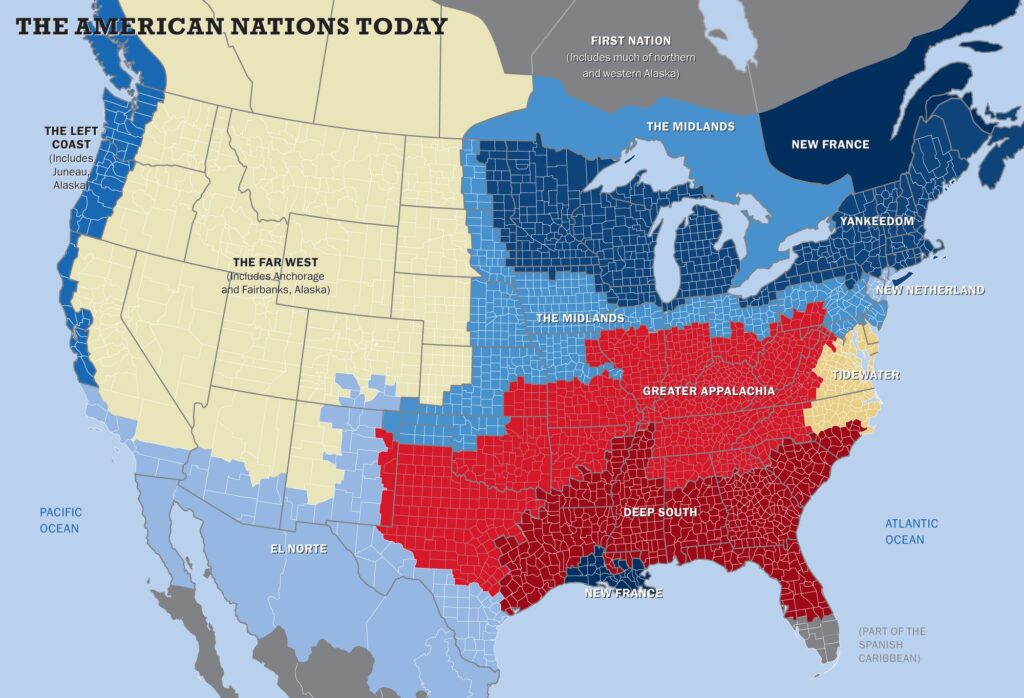As well as having different cultures in the world, we can find different cultures within a same country, as I wrote in my last blog describing the different cultures within Mexico. Today I would like to respond to a question from one of my readers, how many regional subcultures does the U.S.A. have? Does it make a difference if my boss is from New York, or Kentucky or L.A.?
As one can imagine, the U.S.A., if we go back to its origins, shows that it is a melting pot of many cultures. Not only is it composed, as any country within the Americas, from Canada to Brazil or Argentina, of its first native communities found in each of these countries, before the arrival of the first Spanish, French and English colonists, but also migrant groups that have continued to change and influence its main cultural composition over the last 500 or more years and even today.
In this article, I’ll refer to the 11 different American Nations defined by author and journalist Colin Woodard, identified in his book “American Nations: A History of the Eleven Rival Regional Cultures in North America“. He divides the U.S. in the Left Coast, the Far West, El Norte (which includes North of Mexico and today’s south Texas), The West, the Midlands, the Greater Appalachia, the Deep South, and the first colonized regions: the First Nation, Yankeedom, New Netherlands, and New France, which includes the Canadian French region and the French population of Louisiana.

Some U.S.A.’s Regional Cultural differences
I invite you to read the above mentioned book or The Insider article to get a better look, but giving you a taste of some interesting cultural points that distinguish some of these areas.
- As expressed by Andy Kiersz and Marguerite Ward in The Insider article (1), “Composed of the borderlands of the Spanish-American empire, El Norte is “a place apart” from the rest of America, according to Woodard. Hispanic culture dominates in the area, and the region values independence, self-sufficiency, and hard work above all else. Parts of Texas, Arizona, New Mexico, and California are in El Norte.” Nevertheless, having been settled by Mexican and Spanish populations before Caucasian settlers entered the area, is also considered fairly collectivistic.
- Although the U.S. is considered individualistic, because of ecological, historical, and institutional practices, the Deep South is its most collectivistic region. Its defeat in the Civil War, the institution of slavery, relative poverty, and the prominence of religion all contribute to its collectivistic tendencies.
- On the other hand, the Mountain West and Great Plains is thought to be the most individualistic region in the U.S.
- Another example, identified by the study Regional Cultural Differences and Ethical Perspectives within the United States (2) shows Hawaii was directionally higher than Florida (part of the Deep South, for collectivism (CO) and uncertainty avoidance (UA). It is potentially meaningful that Asian cultures, so prevalent in Hawaii, are typically (and comparatively to a U.S. norm) represented by higher propensities for collectivism and UA (Hofstede 1980).
We all come from the same root
…but the leaves are all different.
We may have different backgrounds, but we believe in the same dream that says this is a country where anything’s possible. No matter who you are. No matter where you come from.
Barack Obama
Overall the USA has been identified to be one of the the most Individualist cultures in the world according to the Hofstede dimensions and as reflected in its premise of “liberty and justice for all.” and evidenced by its emphasis on equal rights in all aspects of American society and government.

They emphasize independence, self-sufficiency, individual freedom, and individual choice. Hierarchy is established only for convenience, superiors are accessible, and managers rely on individual employees and teams for their expertise, being all equally consulted and information being easily shared. People look after themselves and their immediate families and do not rely largely on authorities for support.
Awareness is key
So when talking about Intercultural Coaching and the relationships between a U.S. colleague or boss, it is important to identify not only that they are from the States, but also what part or region they are originally from. As I explained in one of my first posts, the Global Executive needs to learn and understand the main differences, first be aware of their own cultural background, not only the country culture they have but also the regional differences they possess.
All the while they must be aware of the new overall national and regional culture before them. Only this awareness will allow them to be sensitive of their fellow coworkers and connections in general and build cultural bridges for the most optimum work relationships.
An Intercultural Executive Coach can help you identify the new cultures you are now coexist in, and how similar and different you are in terms of values, beliefs, or behaviors.
Sources / Further reading
- Kiersz, A & Ward, M. (2020). This map shows how the US really has 11 separate ‘nations’ with entirely different cultures. Extracted from https://www.businessinsider.com/the-11-nations-of-the-united-states-2015-7?r=MX&IR=T
- Macnab, B, Worthley, R. & Jenner, S. Regional Cultural Differences and Ethical Perspectives within the United States: Avoiding Pseudo-Emic Ethics Research. Business and Society Review, Vol. 115, Issue 1, pp. 27-55, Spring 2010



